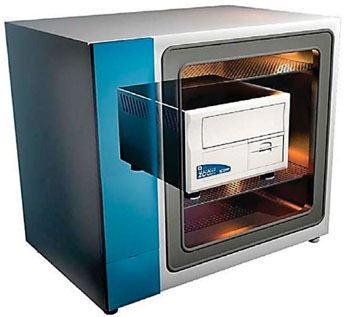Simple Test Predicts Childhood Cancer Relapse
By LabMedica International staff writers
Posted on 26 May 2016
High-risk neuroblastoma, which occurs mostly in children under five, is treated with surgery and chemotherapy, and neuroblastomas currently rated low risk are just removed or left untreated while doctors 'wait and see', but a fraction of low risk tumors recur and ultimately kill.Posted on 26 May 2016
A cheap simple test could accurately predict the recurrence of a childhood cancer, as a protein marker has been pinpointed which when absent, shows neuroblastoma is almost certain to recur. It means children with low-risk neuroblastoma, who do not have the biomarker, can be reclassified as at high risk of relapse and have chemotherapy earlier.

Image: The IncuCyte zoom continuous live-cell imaging and analysis system (Photo courtesy of Essen Biosciences).
Scientists at Brunel University London (UK) and their colleagues collected a retrospective series of primary tumors from neuroblastoma (NB) patients. Formalin-fixed, paraffin-embedded tissue sections from NB tumors were studied. Each tumor area tested contained malignant cells, assessed by histological examination. Quantification of immunofluorescence- or DAB-positive tumor cells was performed on serial tumor tissue sections. Tumor cells were distinguished in the samples using NB-specific marker, the homophilic binding glycoprotein neural cell adhesion molecule (NCAM, CD56).
The scientists carried out cell proliferation assays using IncuCyte live-cell imaging system (Essen Biosciences, Ann Arbor, MI, USA); immunostaining of cultured cells; Western blotting; angiogenesis assays where the images were captured using JuLI smart fluorescent cell analyzer (Baker Ruskinn, Sanford, ME; USA). The investigators used several other methodologies to identify the Promyelocytic Leukaemia protein-1(PML-1) and gene expression was assessed using chip microarrays.
PML was detected in the developing and adult sympathetic nervous system, whereas it was not expressed or low in metastatic neuroblastoma tumors. Reduced PML expression in patients with low-risk cancers, i.e. localized and negative for the V-Myc Avian Myelocytomatosis Viral Oncogene Neuroblastoma Derived Homolog (MYCN) protooncogene was strongly associated with tumor recurrence. PML-I, but not PML-IV, isoform suppresses angiogenesis via upregulation of thrombospondin-2 (TSP-2), a key inhibitor of angiogenesis. Finally, PML-I and TSP-2 expression inversely correlates with tumor angiogenesis and recurrence in localized neuroblastomas.
Paolo Salomoni, PhD, a professor and senior author of the study said, “We have found the absence of PML a very precise marker of tumor recurrence. In the low risk tumors, the absence of PML will be a very useful marker. What we can now say is that even some tumors classified as low risk, that would have previously gone untreated, if they show no expression of PML, they ought now to be classified as high risk.” The study was published on April 13, 2016, in the journal Clinical Cancer Research.
Related Links:
Brunel University London
Essen Biosciences
Baker Ruskinn













